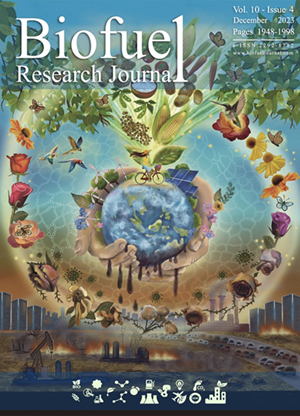Design and construction of artificial microbial consortia to enhance lignocellulosic biomass degradation
IF 11.9
Q1 ENERGY & FUELS
引用次数: 1
Abstract
Cellulose-rich agricultural residues are promising renewable sources for producing various value-added products such as 2nd generation biofuels. However, the efficiency of the bioconversion process is not always satisfactory due to the slow and incomplete degradation of lignocellulosic biomass. An interesting approach would be using microbial communities with high lignocellulose-degrading ability for environmentally friendly pretreatment. This study focused on characterizing the degradation performance of bacteria, fungal, and yeast strains and designing and constructing different microbial consortia for solid-state treatment of wheat bran and wheat straw. The microbial consortia, namely BFY4 and BFY5, contained different bacteria, fungal, and yeast led to high ratios of sugar accumulation ranging from 3.21 to 3.5 with degradation rates over 33%, owing to more favorable hydrolytic enzyme activities and improved reducing sugar yield during the process. After 72 h, the highest FPase (0.213 IU/gds) and xylanase (7.588 IU/gds) activities were also detected in the wheat straw pretreated by BFY4 and BFY5, respectively, while CMCase activity peaked (0.928 IU/gds) when wheat bran was used as substrate. The amount of released glucose increased during the treatment process when the two substrates were used in the same ratio. Our results indicated that substrate composition also plays an important role in the degradation capacity of mixed cultures. These findings can be instrumental in advancing the primary knowledge required to apply such bioprocesses at the pilot scale.人工微生物群落的设计与构建促进木质纤维素生物质降解
富含纤维素的农业残留物是生产第二代生物燃料等各种增值产品的有前景的可再生资源。然而,由于木质纤维素生物质降解缓慢且不完全,生物转化过程的效率并不总是令人满意的。一种有趣的方法是使用具有高木质纤维素降解能力的微生物群落进行环境友好的预处理。本研究的重点是表征细菌、真菌和酵母菌株的降解性能,并设计和构建用于麦麸和麦秆固态处理的不同微生物群落。微生物群落,即BFY4和BFY5,含有不同的细菌、真菌和酵母,导致糖积累率高,范围从3.21到3.5,降解率超过33%,这是因为在这个过程中,水解酶活性更有利,还原糖产量提高。72小时后,BFY4和BFY5预处理的麦秆中FPase和木聚糖酶的活性最高,分别为0.213IU/gds和7.588IU/gds,而以麦麸为底物时CMC酶活性达到峰值(0.928IU/gds)。当两种底物以相同的比例使用时,在处理过程中释放的葡萄糖量增加。我们的研究结果表明,底物组成在混合培养物的降解能力中也起着重要作用。这些发现有助于推进中试规模应用此类生物工艺所需的基本知识。
本文章由计算机程序翻译,如有差异,请以英文原文为准。
求助全文
约1分钟内获得全文
求助全文
来源期刊

Biofuel Research Journal-BRJ
ENERGY & FUELS-
CiteScore
22.10
自引率
1.50%
发文量
15
审稿时长
8 weeks
期刊介绍:
Biofuel Research Journal (BRJ) is a leading, peer-reviewed academic journal that focuses on high-quality research in the field of biofuels, bioproducts, and biomass-derived materials and technologies. The journal's primary goal is to contribute to the advancement of knowledge and understanding in the areas of sustainable energy solutions, environmental protection, and the circular economy. BRJ accepts various types of articles, including original research papers, review papers, case studies, short communications, and hypotheses. The specific areas covered by the journal include Biofuels and Bioproducts, Biomass Valorization, Biomass-Derived Materials for Energy and Storage Systems, Techno-Economic and Environmental Assessments, Climate Change and Sustainability, and Biofuels and Bioproducts in Circular Economy, among others. BRJ actively encourages interdisciplinary collaborations among researchers, engineers, scientists, policymakers, and industry experts to facilitate the adoption of sustainable energy solutions and promote a greener future. The journal maintains rigorous standards of peer review and editorial integrity to ensure that only impactful and high-quality research is published. Currently, BRJ is indexed by several prominent databases such as Web of Science, CAS Databases, Directory of Open Access Journals, Scimago Journal Rank, Scopus, Google Scholar, Elektronische Zeitschriftenbibliothek EZB, et al.
 求助内容:
求助内容: 应助结果提醒方式:
应助结果提醒方式:


